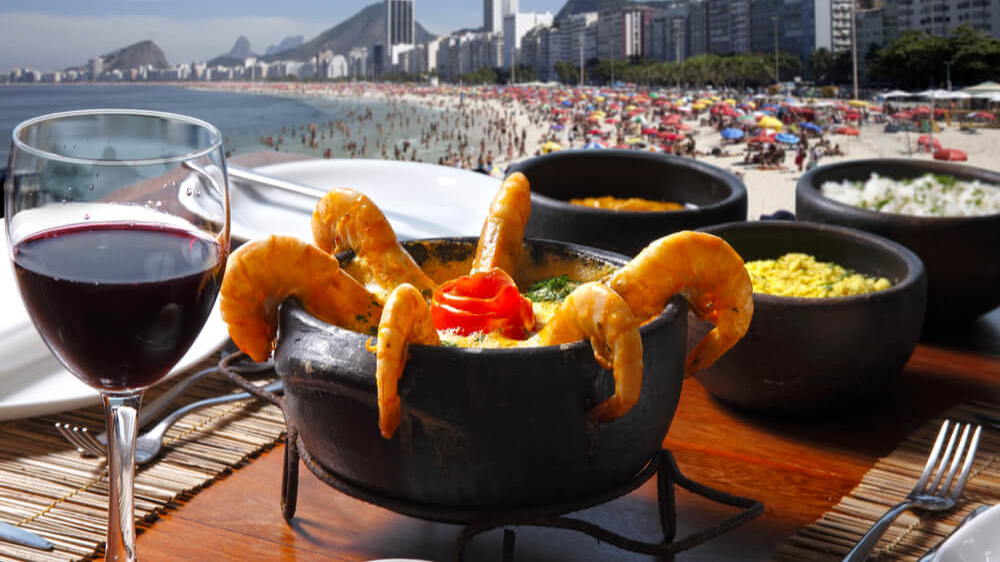Introduction

This Rio de Janeiro itinerary is crafted for travelers seeking to explore the “Cidade Maravilhosa” (Marvelous City), a vibrant metropolis that offers something for everyone, whether you’re on a shoestring budget, planning a family trip, or looking for a luxurious getaway. From the iconic Christ the Redeemer statue perched atop Corcovado Mountain to the sun-kissed sands of Copacabana and Ipanema beaches, Rio is truly a feast for the senses.
This 7-day Rio de Janeiro itinerary is designed to guide first-time visitors through the best that Rio has to offer, balancing must-see landmarks, rich cultural experiences, and opportunities for relaxation. Whether you’re dreaming of indulging in luxurious accommodations and fine dining or exploring the city on a budget, this guide provides options to tailor your trip to your preferences and ensure an unforgettable Carioca adventure.
Get ready to immerse yourself in the rhythm of samba, savor delicious Brazilian cuisine, and discover the magic of Rio de Janeiro! With this itinerary, you’ll experience the city’s breathtaking landscapes, vibrant neighborhoods, and warm hospitality, creating memories that will last a lifetime.
Before You Go: Planning Your Trip

Planning your trip to Rio de Janeiro involves considering the best time to visit, visa requirements, currency exchange, and essential packing items. To ensure a smooth and enjoyable experience, it’s important to be well-prepared before you embark on your Brazilian adventure.
Best Time to Visit
The best time to visit Rio de Janeiro depends on your preferences for weather, crowds, and events. Generally, the summer months from December to March offer warm temperatures and vibrant festivities, including the world-famous Carnival. However, this is also the peak tourist season, which means larger crowds and higher prices. If you prefer milder weather and fewer tourists, consider visiting during the shoulder seasons of April to June or September to November, when you can still enjoy pleasant conditions and local events without the hustle and bustle.
Visa and Entry Requirements
Ensure you have the necessary travel documents and understand the visa requirements for Brazil based on your nationality. U.S. and Canadian citizens will need a valid visa or e-visa to travel to Brazil, EU (European Union) and UK citizens can visit Brazil without a visa for up to 90 days per entry. Check the latest entry requirements, including visa requirements for every country, documentation, and health-related regulations, to avoid any last-minute surprises. It’s also a good idea to have a printed copy of your travel itinerary and accommodation details handy when you arrive.
Currency and Budgeting
The Brazilian currency is the Real (BRL), and budgeting depends on your travel style. While Rio offers a range of options for every budget, it’s essential to plan your expenses accordingly. For affordable travelers, street food and public transportation can help keep costs down, while luxury seekers can indulge in fine dining and upscale experiences. Be sure to notify your bank of your travel plans to avoid any issues with using your credit or debit cards abroad. And even though Brazil has a high payment digitalization, consider carrying some cash for smaller purchases.
What to Pack
Packing for Rio requires considering the warm climate, diverse activities, and your style. Lightweight, breathable clothing is essential for the tropical weather, while comfortable shoes are a must for exploring the city’s hilly terrain. Don’t forget to bring swimwear for the beaches, hat and sunglasses for sun protection, and a light jacket for cooler evenings. Additionally, if you plan to hike or explore the lush landscapes, pack appropriate gear.
Accommodation Options

Rio offers a wide range of accommodation options, from budget-friendly hostels to luxurious hotels with stunning views. Choosing the right place to stay can significantly enhance your experience, providing comfort, convenience, and a taste of the local culture.
Budget-Friendly Hostels and Guesthouse
For budget travelers, hostels and guesthouses provide affordable and social accommodation options. These establishments often offer dormitory-style rooms (shared rooms) or private rooms at reasonable prices, making them ideal for solo travelers or those looking to meet new people. Amenities typically include shared bathrooms, common areas for socializing, and sometimes a basic breakfast. Many hostels also organize social events and tours, providing opportunities to explore the city with fellow travelers. Popular neighborhoods for budget accommodations include Santa Teresa, known for its bohemian vibes and artistic atmosphere, and Botafogo, which offers a mix of affordability and proximity to attractions. Expect to pay around $10-$30 per night for a dorm bed or $30-$60 for a private room.
You can check out some options for budget accommodations here
Mid-Range Hotels and Apartments
Mid-range hotels and apartments offer a balance of comfort and affordability. These options typically provide private rooms with amenities such as air conditioning, Wi-Fi, and breakfast included. You can expect services like daily housekeeping, on-site restaurants or cafes, and sometimes a pool or gym. Apartments can be a great choice for families or groups, offering more space and the convenience of a kitchen. Neighborhoods like Copacabana and Ipanema have a variety of mid-range hotels and apartments within walking distance of the beach and other attractions. Prices generally range from $70-$150 per night.
You can check out some options for budget accommodations here
Luxury Hotels and Resorts
Indulge in a luxurious stay at one of Rio’s top-tier hotels and resorts. These establishments offer world-class amenities, impeccable service, and stunning views of the city and coastline. Expect services like concierge assistance, multiple on-site restaurants, spa facilities, private beach access, and opulent rooms with high-end finishes. From rooftop pools and gourmet restaurants to spa treatments and private beach access, luxury hotels provide an unforgettable experience. Iconic hotels like the Belmond Copacabana Palace and the Fasano Rio are renowned for their elegance and sophistication, attracting discerning travelers from around the globe. Staying in neighborhoods like Ipanema, Copacabana, or Barra da Tijuca will give you access to these high-end options. Prices start around $200 per night and can exceed $1000.
You can check out some options for budget accommodations here
7-Day Rio de Janeiro Itinerary
Day 1: Arrival & Copacabana Beach – Sun, Sand, and Samba Spirit

Settle into your chosen accommodation. For a budget option, look for hostels or guesthouses in Copacabana or nearby Botafogo. If you’re looking into luxury alternatives, check into a beachfront hotel on Avenida Atlântica, like the Copacabana Palace, for unparalleled views and service.
After settling in, head straight to the famous Copacabana Beach. This iconic stretch of white sand and blue waters has captivated visitors for decades. Rent a beach chair and umbrella from one of the many vendors, order a refreshing caipirinha, and simply soak up the sun. Take a dip in the ocean, try your hand at frescobol (a local beach paddle game), or simply people-watch.
As the sun begins to set, stretch your legs and take a leisurely stroll along the beachfront promenade, known as the calçadão. Admire the iconic wave-patterned mosaic tiles, watch street performers showcase their talents, and browse the vibrant array of vendors selling everything from souvenirs to artwork. For dinner, choose from a variety of options. In the budget side options, go for a botequim (local bar) serving petiscos (tapas) and cold beer. Looking for a high-end experience, dine at a restaurant with ocean views, indulging in fresh seafood and Brazilian specialties.
Day 2: Christ the Redeemer & Sugarloaf Mountain – Reaching New Heights

Start your day early to visit two of Rio’s most iconic landmarks: Christ the Redeemer and Sugarloaf Mountain.
You can find a wide range of tour packs for this two attractions, you can find some options here
Christ the Redeemer: Purchase tickets in advance online to avoid long queues. Choose between taking a van from Copacabana or Laranjeiras or hopping on the cogwheel train through the Tijuca Forest. As you ascend Corcovado Mountain, anticipation builds. Standing at the base of the awe-inspiring Christ the Redeemer statue, you’ll be rewarded with breathtaking panoramic views of the entire city, including Copacabana and Ipanema beaches, Sugarloaf Mountain, and Guanabara Bay.
Sugarloaf Mountain: After visiting Christ the Redeemer, head to Sugarloaf Mountain in the Urca neighborhood. Take two cable car rides, the first to Morro da Urca and the second to the summit of Sugarloaf, for breathtaking 360-degree views of the Atlantic Ocean, Copacabana Beach, Guanabara Bay, and the surrounding islands. Enjoy lunch at a restaurant on Morro da Urca with spectacular views. Budget: Pack a picnic to enjoy at the top. Luxury: Enjoy a fine dining experience with unparalleled views.
In the evening, consider a Samba show. Budget: Look for smaller, local Samba circles in Lapa. Luxury: Attend a renowned Samba show with dinner included.
Day 3: Santa Teresa & Lapa – Bohemian Charm and Rhythmic Nights

Immerse yourself in the bohemian spirit of Santa Teresa, a charming hilltop neighborhood known for its cobblestone streets, art galleries, colorful houses, and stunning views (here some options of tours packs with online tickets)
Explore the neighborhood on foot, starting with a ride on the iconic yellow Santa Teresa Tram (known locally as “bondinho”). Visit the Parque das Ruínas (Park of Ruins), a cultural center housed in the ruins of a mansion, offering panoramic city views and art exhibitions. Browse the art galleries and studios showcasing the works of local artists. Stop for a coffee or lunch at one of the sidewalk cafes, soaking up the neighborhood’s artistic atmosphere. Budget: Enjoy a simple meal at a “kilo” restaurant, where you pay by weight. Luxury: Indulge in a gourmet meal at a restaurant with panoramic views.
In the evening, experience the vibrant nightlife of Lapa, a historic neighborhood known for its lively bars, clubs, and live music venues. Stroll along the iconic Selarón Steps, a colorful mosaic staircase created by Chilean artist Jorge Selarón. Enjoy live music at a Samba club or a “forró” (a traditional style of music from the northeast of Brazil) venue. Budget: Join a street party and enjoy the lively atmosphere. Luxury: Enjoy a cocktail at a rooftop bar with stunning city views.
Day 4: Ipanema Beach & Arpoador – Beach Bliss and Sunset Spectacle

Dedicate a day to relaxing and enjoying the beauty of Ipanema Beach, another of Rio’s most iconic and beautiful beaches. Rent a beach chair and umbrella, take a refreshing dip in the ocean, and soak up the sun. Ipanema is known for its sophisticated atmosphere and stunning views of the coast and mountains.
In the late afternoon, head to Arpoador Rock, located at the end of Ipanema Beach, to witness one of Rio’s most spectacular sunsets. Arrive early to secure a good spot and watch as the sun dips below the horizon, painting the sky with vibrant colors. Cheer along with the locals as the sun disappears, a tradition that has become a ritual in Rio. Budget: Grab a beer from a street vendor and enjoy the sunset. Luxury: Enjoy cocktails at a beachside bar while watching the sunset. For dinner, explore the diverse culinary scene in Ipanema.
Day 5: Tijuca National Park & Botanical Garden – Nature’s Embrace

Escape the city bustle and immerse yourself in the lush greenery of Tijuca National Park, one of the largest urban forests in the world. Hike through the park’s trails, discover hidden waterfalls, and enjoy breathtaking views of the city and coastline.
After exploring the park, visit the Botanical Garden, a 137-hectare oasis showcasing the incredible biodiversity of Brazil. Stroll through the garden’s palm-lined avenues, admire the diverse collection of plants and flowers, and visit the orchidarium and the Japanese garden. Budget: Pack a picnic lunch and enjoy it in the park or garden. Luxury: Hire a private guide for a personalized tour of the park and garden.
Day 6: Favela Tour & Cultural Immersion – Beyond the Postcard

Gain a deeper understanding of Rio’s culture and social landscape with a guided favela tour. This experience offers a glimpse into the daily lives of residents in one of Rio’s favelas (informal settlements). Choose a reputable tour operator that works with the community and provides economic benefits to its residents.
A favela tour offers a unique opportunity to interact with the community, learn about their challenges and triumphs, and witness their resilience and creativity. Be respectful and mindful of the local customs and traditions. The best tours support the favela through tourism dollars that are reinvested in local programs. Budget: Choose a walking tour with a local guide. Luxury: Opt for a private tour with transportation and lunch at a local restaurant.
Day 7: Departure or Optional Activities – Farewell, Rio!
Depending on your flight schedule, enjoy a final morning in Rio or explore optional activities that cater to your interests.
Enjoy a final Brazilian breakfast or lunch before heading to the airport, filled with memories of your unforgettable Rio de Janeiro adventure.
Optional Activities:

- Explore the historic district of Centro, visiting landmarks such as the Municipal Theatre and the National Library.
- Discover the vibrant street art scene in Valverde Street in Santa Teresa.
- Visit the Museum of Tomorrow a futuristic spaceship shape like building, located in Guanabara Bay, dedicated to ecological and tech exhibition.
- Visit the Aquario, the city aquarium
- Take a surfing lesson at one of Rio’s beaches.
- Visit a local market and sample Brazilian delicacies.
- Relax at a spa and enjoy a Brazilian massage.
A Culinary Journey Through Rio: Food & Drink

Rio de Janeiro’s culinary landscape is as vibrant and diverse as the city itself. From humble street food carts offering quick bites to elegant restaurants showcasing innovative cuisine, there’s a flavor profile to satisfy every palate and budget. Exploring the food scene is an integral part of experiencing Rio’s culture and its people.
Must-Try Brazilian Dishes: A Taste of Tradition

No trip to Rio is complete without sampling the quintessential Brazilian dishes that define the nation’s culinary identity. Start with feijoada, often considered Brazil’s national dish. This hearty and flavorful black bean stew is simmered with various cuts of pork and smoked sausages. It’s traditionally served with fluffy white rice, finely shredded collard greens, bright orange slices (to aid digestion), and farofa, toasted cassava flour that adds a unique textural element.
Next, indulge in the simple pleasure of pão de queijo, those addictively cheesy bread rolls. These small, chewy spheres are made with tapioca flour and cheese, creating a unique and satisfying snack, perfect any time of day. Don’t forget to try them fresh from the oven!
For a sweet ending, brigadeiro is a must. These decadent chocolate fudge balls are a staple at Brazilian parties and celebrations. Made with condensed milk, cocoa powder, and butter, they’re rolled in chocolate sprinkles for a delightful treat that showcases Brazil’s love affair with chocolate. Beyond these staples, be sure to venture out and try moqueca, a flavorful seafood stew, or vatapá, a creamy shrimp dish originating from Bahia, showcasing the rich culinary diversity across the country.
Affordable Eats: Street Food & Local Markets – Savoring Rio on a Budget

Rio’s vibrant street food scene and bustling local markets offer a fantastic and affordable way to experience the city’s culinary delights. Street food stalls, known as barraquinhas, are ubiquitous and offer a tempting array of treats.
Grab a pastel, a crispy, deep-fried pastry filled with savory or sweet ingredients like cheese, ground beef, shrimp, or even guava paste. These are perfect for a quick and satisfying bite on the go.
For the meat lovers, espetinhos are a must-try. These grilled meat skewers, often marinated in flavorful spices, are readily available from street vendors and offer a delicious and protein-packed snack.
Venture into local markets like the Mercado Central do Rio de Janeiro (also known as Cadeg) for a sensory overload of sights, smells, and tastes. Sample fresh and exotic fruits like açai and maracujá (passion fruit), discover local cheeses and cured meats, and find regional specialties like homemade jams and cachaça (Brazilian rum). Interacting with local vendors and sampling their products provides an authentic and cost-effective way to immerse yourself in the local culinary culture. Don’t be afraid to try something new; you might just discover your new favorite Brazilian snack!
Fine Dining Experiences: Elevating Brazilian Cuisine

For a truly unforgettable culinary experience, indulge in a meal at one of Rio’s upscale restaurants. Many of these establishments boast breathtaking ocean views, creating a stunning backdrop for a memorable meal. These restaurants often showcase innovative menus that expertly blend traditional Brazilian ingredients with modern culinary techniques, resulting in dishes that are both familiar and surprising.
Expect beautifully presented plates, impeccable service, and a sophisticated ambiance that enhances the dining experience. Consider exploring restaurants in upscale neighborhoods like Ipanema or Leblon, known for their concentration of world-class dining options. Look for establishments that highlight locally sourced ingredients and offer tasting menus that allow you to sample a variety of dishes.
From seafood restaurants showcasing the freshest catches of the day to steakhouses offering premium cuts of Brazilian beef, Rio’s fine dining scene promises a refined and elevated culinary journey. Make reservations in advance, especially during peak season, to secure your spot at these sought-after destinations.
Transportation: Navigating the Marvels of Rio

Rio de Janeiro offers a diverse array of transportation options, making it surprisingly easy to explore its iconic landmarks, hidden gems, and vibrant neighborhoods. Whether you’re drawn to the sun-kissed beaches of Copacabana and Ipanema, the cultural heart of Lapa, or the artistic haven of Santa Teresa, understanding your transportation choices is key to a smooth and rewarding experience. Forget worrying about logistics and immerse yourself in the Carioca spirit!
Public Transportation: The Heartbeat of Rio (Metro, Buses, BRT)

Rio’s public transport is a budget-friendly and often efficient way to experience the city like a local.
- Metro: The Rio Metro is clean, safe (especially during peak hours), and air-conditioned, offering a fast and reliable way to travel between key areas. There are currently three lines. Line 1 runs between General Osório (Ipanema) and Uruguai (Tijuca), Line 2 runs from Botafogo to Pavuna (a more local area), and Line 4 connects Ipanema to Barra da Tijuca. It is the newest line and extremely helpful for reaching areas west of the city. You can purchase individual tickets, pre-loaded travel cards (RioCard Mais!), or even use contactless payment options at some stations. Consider downloading the MetroRio app for schedules, route planning, and real-time updates. Keep in mind that during peak hours, the metro can get very crowded, especially on the Copacabana-Catete-Matrizes line.
- Buses: With hundreds of routes covering virtually every corner of the city, Rio’s bus network is extensive. However, navigating it can be challenging for non-Portuguese speakers. Citymapper and Moovit apps are your best friends here. They provide real-time bus tracking, route suggestions, and fare information. Fares are paid in cash directly to the conductor. Be prepared to pay with smaller bills, as change can sometimes be limited. Be aware of your surroundings on buses, particularly during rush hour, and keep your belongings secure. Buses can be crowded and hot (some are air-conditioned, many are not!).
- BRT (Bus Rapid Transit): The BRT is a network of dedicated bus lanes that offer a faster alternative to regular buses, especially for traveling longer distances. There are three main BRT lines: Transoeste, Transcarioca, and Transolímpica. They are useful for reaching areas like Barra da Tijuca, the Olympic Park, and the airport. You’ll need to purchase a specific BRT card to use these services.
- Santa Teresa Tram (Bondinho): Reopened after a period of closure, the historic Santa Teresa tram (Bondinho) is more than just transportation; it’s an experience. It winds its way through the charming, hilly neighborhood of Santa Teresa, offering stunning views and a glimpse into Rio’s bohemian past. Check the official website for the most up-to-date schedules and ticket information.
Taxis, Ride-Sharing & Other Alternatives: Convenience and Comfort

- Taxis: Official yellow taxis are readily available and can be hailed on the street. Ensure the meter is running or negotiate a price before starting your journey. Taxi apps such as Guia-Rio/Taxi Rio and 99 (that can be use to taxis and ride-sharing) can also be used. Be aware of potential traffic congestion, which can significantly increase the fare. Taxi drivers generally only accept cash.
- Ride-Sharing Services (Uber, Cabify, 99): Apps like Uber, Cabify, and 99 are widely used in Rio and often provide a more convenient and transparent pricing option compared to traditional taxis. You can track your ride in real-time, pay via credit card, and avoid language barriers with translated interfaces. While generally safe, it’s always wise to check the driver’s rating and vehicle details before entering.
- Motorcycle Taxis (Moto-Taxis): While a faster alternative for short distances, especially in congested areas, moto-taxis are generally not recommended for tourists due to safety concerns and lack of insurance coverage in case of accidents. If you choose to use one, ensure the driver provides a helmet and negotiate the fare beforehand.
- Bike Sharing (Bike Itaú): Rio has an extensive bike-sharing program, Bike Itaú, with stations located throughout the city, particularly in tourist areas. This is a fantastic way to explore the beaches and bike paths along the coast. Download the app, register, and rent a bike for a specific duration. Be mindful of traffic and pedestrian flow.
- Walking: Rio is a very walkable city, and there are many amazing sights to be seen by foot. However, use common sense, be aware of your surroundings, and stick to well-lit, populated areas.
Safety Tips: Ensuring a Secure and Enjoyable Stay

Rio is a dynamic and captivating city, but it’s crucial to prioritize your safety. Preparation and awareness are key to minimizing risks.
General Safety Advice: Vigilance is Your Best Defense
- Be Aware of Your Surroundings: This is the most important tip. Pay attention to your environment, especially in crowded areas, on public transport, and at night.
- Protect Your Belongings: Avoid displaying expensive jewelry, watches, or smartphones. Keep your valuables secured in a money belt or a hidden pocket. Never leave your belongings unattended, even for a moment. When using your phone in public, be aware of people around you.
- Avoid Walking Alone at Night: Stick to well-lit and populated areas, especially after dark. If you need to travel alone at night, consider taking a taxi or ride-sharing service.
- Plan Your Route: Familiarize yourself with your route beforehand and avoid getting lost in unfamiliar neighborhoods. Use offline maps on your phone to avoid relying on internet access.
- Learn Basic Portuguese Phrases: Knowing a few basic phrases can be helpful in communicating with locals and asking for assistance.
- Emergency Numbers:
- Police: 190
- Fire Department: 193
- Ambulance: 192
- Tourist Police (Delegacia Especial de Atendimento ao Turista – DEAT): (21) 2332-2924
- Make Copies of Important Documents: Keep copies of your passport, visa, and other important documents in a separate location from the originals.
Common Scams and How to Avoid Them: Outsmarting the Opportunists
- Pickpocketing: Be extra vigilant in crowded areas like buses, metro stations, and markets. Keep your belongings close to your body and consider using a cross-body bag.
- ATM Scams: Use ATMs located inside banks or in secure locations. Be wary of ATMs that appear to be tampered with. Cover the keypad when entering your PIN.
- Overpricing: Always negotiate prices before making a purchase, especially in markets and with street vendors.
- Fake Police Officers: Be suspicious of anyone claiming to be a police officer who asks for your passport or money. Real police officers rarely approach tourists in this manner. If in doubt, politely decline and find a uniformed officer to verify their identity.
- The “Must-See” Bracelet Scam: A friendly person approaches you and places a bracelet on your wrist, claiming it’s a gift. They then demand payment for the bracelet. Politely refuse and walk away.
- The Distraction Scam: Someone creates a distraction while an accomplice attempts to steal your belongings. Be aware of overly friendly strangers or staged arguments.
- Be Wary of Free Tours that Aren’t: Some offer seemingly free tours, only to heavily pressure you into buying overpriced souvenirs or services at the end. Inquire about potential costs beforehand.
Conclusion: Embrace the Carioca Vibe with Confidence
Rio de Janeiro is an unforgettable destination that offers a unique blend of natural beauty, vibrant culture, and warm hospitality. By familiarizing yourself with the city’s transportation options, practicing essential safety precautions, and embracing the Carioca spirit, you’ll be well-equipped for a truly memorable adventure. From the iconic Christ the Redeemer statue to the pulsating samba rhythms of Lapa, Rio has something to captivate every traveler. So, pack your bags, brush up on your Portuguese, and get ready to experience the magic of Rio!






